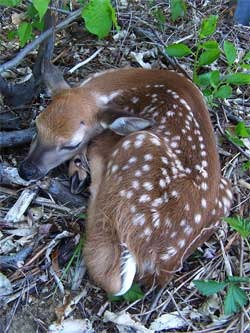OLYMPIA – With temperatures rising and summer drawing near, the Washington Department of Fish and Wildlife (WDFW) is reminding campers, hikers and others who enjoy spending time outdoors to leave any wildlife they encounter alone.
With deer fawns, raccoons, seal pups, baby birds and other young animals now on view around the state, the department is receiving an increasing number of calls from people asking what to do with animals they have “rescued” from the wild, said Mick Cope, WDFW game manager.
“People find young animals and birds alone and assume they’ve been abandoned by their parents,” Cope said. “In fact, their parents are usually nearby and may even be watching as their fawns, kits, and chicks are removed by would-be rescuers.”
Cope said deer often leave their young for hours at a time to forage and avoid attracting predators with their own body scent. The best thing people can do if they find a fawn without its mother is to leave it alone so its mother can return to it, he said.
“Even with the best intentions, removing animals from the wild greatly reduces their chance of survival,” Cope said.
Tina Hamilton, statewide dispatcher for WDFW’s law enforcement program, has seen a marked increase in reports of “rescued” wildlife in recent weeks.
“We recently had a situation where someone picked up a newborn fawn and left it at a fire station in rural Pierce County,” Hamilton said. “That fawn still had its umbilical cord, so how far away could its mother have been?”
While WDFW may attempt to place displaced animals with wildlife rehabilitators, many do not survive, Cope said.
He also noted that holding wildlife in captivity is a misdemeanor in Washington state. Under state law, only licensed wildlife rehabilitators can hold wildlife in captivity.
“If people want to help, we ask that they give young wildlife a wide berth and restrain pets that might harass them,” Cope said. “Cats, in particular, can take a toll on songbirds if they’re left to roam outdoors.”
For more information about appropriate behavior around wildlife, see WDFW’s Living with Wildlife website at http://wdfw.wa.gov/conservation/health/rehabilitation/when_not_to_rescue.html.


